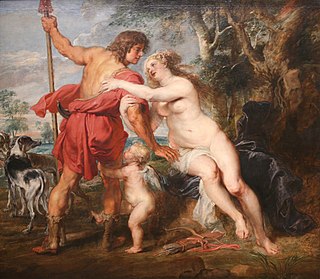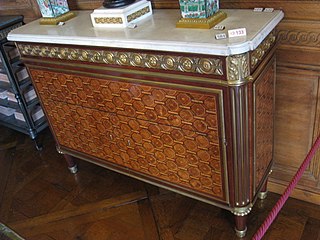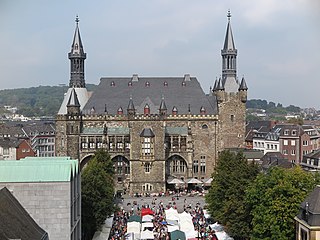
The Baroque is a Western style of architecture, music, dance, painting, sculpture, poetry, and other arts that flourished from the early 17th century until the 1750s. It followed Renaissance art and Mannerism and preceded the Rococo and Neoclassical styles. It was encouraged by the Catholic Church as a means to counter the simplicity and austerity of Protestant architecture, art, and music, though Lutheran Baroque art developed in parts of Europe as well.

Rococo, less commonly Roccoco, also known as Late Baroque, is an exceptionally ornamental and dramatic style of architecture, art and decoration which combines asymmetry, scrolling curves, gilding, white and pastel colours, sculpted moulding, and trompe-l'œil frescoes to create surprise and the illusion of motion and drama. It is often described as the final expression of the Baroque movement.

Maaseik is a city and municipality in the Belgian province of Limburg. Both in size and in population, it is the 8th largest municipality in Limburg. The town is the seat of the administrative arrondissement of Maaseik (kieskanton). Internationally, Maaseik is known as the assumed birthplace of the famous Flemish painters Jan and Hubert van Eyck.

Monschau is a small resort town in the Eifel region of western Germany, located in the Aachen district of North Rhine-Westphalia.

The Empire style is an early-nineteenth-century design movement in architecture, furniture, other decorative arts, and the visual arts, representing the second phase of Neoclassicism. It flourished between 1800 and 1815 during the Consulate and the First French Empire periods, although its life span lasted until the late-1820s. From France it spread into much of Europe and the United States.

Stiftsgården is the royal residence in Trondheim, Norway. It is centrally situated on the city’s most important thoroughfare, Munkegaten. At 140 rooms constituting 4000 m² (43000 ft²), it is one of the largest wooden buildings in Northern Europe, and it has been used by royalty and their guests since 1800.

The Basel Historical Museum is one of the largest and most important museums of its kind in Switzerland and a heritage site of national significance. It opened in 1892. The museum is divided into three buildings within the city of Basel: the Barfüsserkirche, Haus zum Kirschgarten and Musikmuseum.

Neoclassical architecture, sometimes referred to as Classical Revival architecture, is an architectural style produced by the Neoclassical movement that began in the mid-18th century in Italy, France and Germany. It became one of the most prominent architectural styles in the Western world. The prevailing styles of architecture in most of Europe for the previous two centuries, Renaissance architecture and Baroque architecture, already represented partial revivals of the Classical architecture of ancient Rome and ancient Greek architecture, but the Neoclassical movement aimed to strip away the excesses of Late Baroque and return to a purer, more complete, and more authentic classical style, adapted to modern purposes.

Rocaille was a French style of exuberant decoration, with an abundance of curves, counter-curves, undulations and elements modeled on nature, that appeared in furniture and interior decoration during the early reign of Louis XV of France. It was a reaction against the heaviness and formality of the Louis XIV style. It began in about 1710, reached its peak in the 1730s, and came to an end in the late 1750s, replaced by Neoclassicism. It was the beginning of the French Baroque movement in furniture and design, and also marked the beginning of the Rococo movement, which spread to Italy, Bavaria and Austria by the mid-18th century.

The Bavarian National Museum in Munich is one of the most important museums of decorative arts in Europe and one of the largest art museums in Germany. Since the beginning the collection has been divided into two main groups: the art historical collection and the folklore collection.

The Curtius Museum is a museum of archaeology and decorative arts located on the bank of the river Meuse in Liège, Belgium. It is classified as a Major Heritage of Wallonia.

The architecture of Germany has a long, rich and diverse history. Every major European style from Roman to Postmodern is represented, including renowned examples of Carolingian, Romanesque, Gothic, Renaissance, Baroque, Classical, Modern and International Style architecture.

Łańcut Castle is a complex of historical buildings located in Łańcut, Subcarpathian Voivodeship, Poland. Historically the residence of the Pilecki, Lubomirski and Potocki families, the complex includes a number of buildings and is surrounded by a park. The castle is one of Poland's official national Historic Monuments, as designated September 1, 2005, and tracked by the National Heritage Board of Poland.

French furniture comprises both the most sophisticated furniture made in Paris for king and court, aristocrats and rich upper bourgeoisie, on the one hand, and French provincial furniture made in the provincial cities and towns many of which, like Lyon and Liège, retained cultural identities distinct from the metropolis. There was also a conservative artisanal rural tradition of French country furniture which remained unbroken until the advent of the railroads in the mid-nineteenth century.

The Fotomuseum aan het Vrijthof is a museum of photography in Maastricht, Netherlands.

Red Crayfish Pharmacy is a baroque building and former pharmacy from the 16th century in the Old Town of Bratislava, Slovakia. Since 1953 it houses the Museum of Pharmacy of the Bratislava City Museum. Today, the exhibition features three of the original five rooms of the former pharmacy complete with historical furniture, pharmacy equipment and Baroque – Classicist paintings and wall decorations. The museum contains an original edition of works by Paracelsus from 1574.
Despite its size, Belgium has a long and distinguished artistic tradition that goes back to the Middle Ages, considerably pre-dating the foundation of the current state in 1830. Art from the areas making up modern Belgium is called in English Netherlandish up to the separation with the Netherlands from 1570 on, and Flemish until the 18th century.

Aachen Town Hall is a landmark of cultural significance located in the Altstadt of Aachen, Germany. It was built in the Gothic style in the first half of the 14th century.
Joseph Moretti was a German architect of Italian birth of the late baroque era. Born in Milan, he primarily worked in the cities of Aachen, Liège, and Maastricht. His first important design was the design for the library at the Rolduc in the rococo style. He also designed the west chapel of the Aachen Cathedral.

The Ansembourg Museum is a museum in the Belgian city of Liège. It is housed in the hôtel d'Ansembourg on Féronstrée in the historic heart of the city.


















